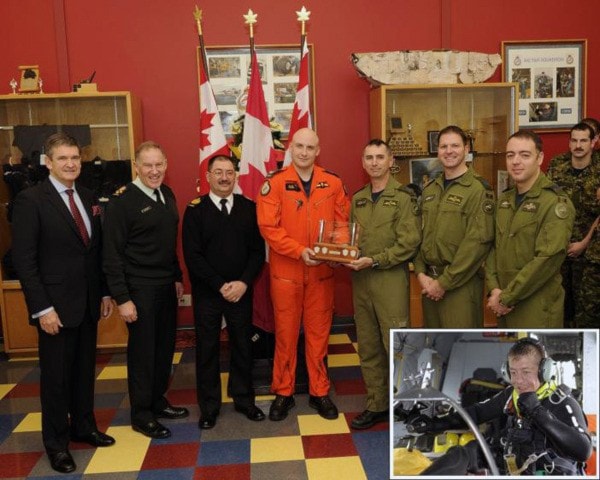The daring cliff-side rescue of a lucky British Columbia hiker that pushed the rescue crew and their search and rescue helicopter to the limits has been named this year’s winner of the Cormorant Trophy for Helicopter Rescue.
Members of 442 Squadron stationed at Canadian Forces Base Comox were presented with their trophy recently by Jeremy Tracy of AgustaWestland, accompanied by Canada’s Chief of Defence Staff Gen. Walter Natynczyk and base commander Col. Jim Benninger.
It was the second time in three years 442 Squadron has earned the award.
Capt. Jean Leroux, aircraft commander; Maj. Troy Maa, first officer; Sgt. Carl Schouten, flight engineer; and search and rescue technician (SARTech) Master Cpl. Nicholas Nissen received the award. Another member of the rescue team, SARTech Sgt. George Olynyk, is now stationed at CFB Gander.
As he presented the Cormorant Trophy, Gen. Natynczyk said, “Their dedication is an example of extraordinary professionalism. We recognize the risks that sometimes must be taken to keep Canadians safe.”
The Cormorant Trophy for Helicopter Rescue recognized the "Canadian civilian, government or military crew that has performed the most demanding helicopter rescue of the year." The trophy is presented annually by AgustaWestland, a Finmeccanica company. The selection is made by a panel of judges that includes representatives of the Canadian Forces and Canada’s aerospace journalists.
“This was one of the most challenging missions of my career,” Capt. Leroux told the Canadian Forces at the time of the rescue.
“Each year, Canadian Forces search and rescue teams conduct thousands of missions on Cormorant helicopters saving dozens of lives,” said Tracy in presenting the award. “The calibre of all the rescue nominations this year made the selection committee’s job quite a challenge. The winning rescue was selected from among five nominees from SAR squadrons across Canada.
“In honouring this particular rescue this year, what stands out is the selflessness of the crew, their determination in saving a life, and the unwavering reliance and trust they had in themselves and their helicopter to get an extremely difficult job done right,” said Mr. Tracy.
On the night of Dec. 23, 2010, the Cormorant helicopter Rescue 907, stationed with 442 Squadron at CFB Comox, was dispatched to rescue a 23-year-old man who was stranded on a steep side of Hat Mountain in Cypress Provincial Park.
The Cormorant crew were racing against time, with a powerful winter storm approaching. Unless the rescue could be carried out, the man would be stranded for days without the necessary provisions to survive.
The stranded hiker was located 1,600 metres up the mountain, 150 metres into dense clouds, in a narrow and steep bowl. As the crew approached in their AW101 Cormorant helicopter, they were battered by 85 km/h wind gusts blowing straight down the mountain.
This forced the pilots to fight rapid power swings, causing significant rotor speed changes and making control of the helicopter very difficult. Using night vision gear, the search team was able to only make out a faint light, which they hoped was their rescue target.
“We reached the estimated location of the hiker by slowly flying up the side of the mountain,” said Capt. Leroux. “We had to attempt multiple passes until the visibility was good enough for us to fly over the man’s location.”
Each of these approaches pushed the helicopter with its three powerful engines to its limit. Normally, the “maximum” speed or power required for missions in an AW101 Cormorant reached about 80 per cent, but during this rescue, the power fluctuated up to 117 per cent, prompting constant warning alarms.
Facing the high risk of an avalanche, the crew decided on a fast extraction with the SARTech remaining attached to the hoist. The flight engineer then directed the aircraft about seven metres above the hiker with a vertical rock face just one-and-a-half to three metres in front of the rotor blades.
The flight engineer lowered the SARTech, who quickly hooked up the rescue subject and both men were hoisted on board. Throughout this procedure, the snow was being whipped around the helicopter enveloping it in a “snowball” drastically reducing the pilots’ visibility.
As they went to fly away, a thick layer of cloud moved in, making it impossible to backtrack the way they came in. With almost no visibility, the flight crew managed to extract the helicopter from the cliff confines relying only on instrumentation to show them the way out.
The crew flew to Lyons Bay soccer field, where the man was transferred to a land ambulance to be taken to hospital for treatment for mild hypothermia.
In 2007 and 2010, 442 Squadron earned the Prince Philip Helicopter Rescue Award for an act of outstanding courage or devotion to duty in the course of land or sea search and rescue operations.
— AgustaWestland
